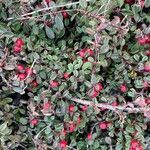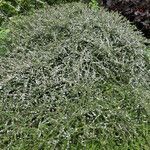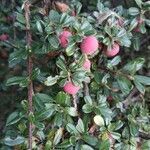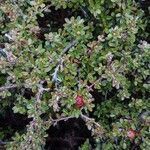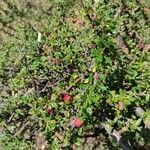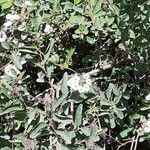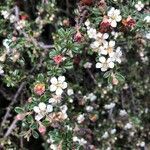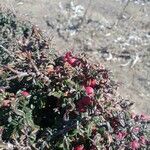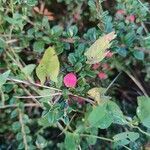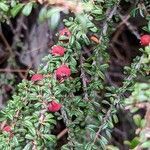Shrubs evergreen, , low, to 1 m tall, with stiff spreading branches. Branchlets reddish brown to blackish brown, terete, initially yellow pubescent, gradually glabrate. Petiole 1–2 mm to more than 4 mm, pubescent; stipules caducous, lanceolate or linear, nearly as long as petioles, slightly pubescent; leaf blade obovate to oblong-obovate, 4–10(–16) × 4–8 mm, thickly leathery, midvein raised abaxially and impressed adaxially, abaxially gray pubescent, rarely glabrous, adaxially glabrous or sparsely pubescent, base broadly cuneate, margin revolute, apex obtuse, rarely emarginate or ± acute. Inflorescences 1(–3)-flowered. Flowers 8–10 mm in diam. Pedicel 2–3 mm, sparsely pubescent. Hypanthium campanulate, abaxially pubescent at least initially. Sepals ovate-triangular, 1–1.5 mm and nearly as broad, apex obtuse. Petals spreading, white, suborbicular, ca. 4 mm and ca. as broad, base shortly clawed, apex obtuse. Stamens 15–20, shorter than petals. Ovary pubescent apically; styles 2, free, somewhat not exceeding stamens. Fruit scarlet-red, globose, 5–6(–10) mm in diam., pyrenes 2. Fl. May–Jun, fr. Aug–Sep. 2n = 34, 51, 68*, 102.
More
An evergreen shrub. It has many branches. It is compact with many twigs. It often lies along the ground. It often forms a mound 1 m high. The leaves have short stalks. The leaves are 0.3-1.5 cm long by 0.2-0.5 cm wide. They are oval and leathery. They are glossy dark green above. The flowers occur singly. They are white and in the axils of leaves. The fruit is round and scarlet when ripe.
It is a temperate plant. They are very frost hardy. It needs an exposed position with full sun. In Nepal they grow between 1300-3500 m altitude. In Uttar Pradesh in India they grow between 2000-4000 m altitude. It is best in a light to medium well-drained soil. It suits hardiness zones 5-10. In Sichuan and Yunnan.
More
Trailing on rocks or spreading on grassy hillsides, 1200-5400 metres. Rocky slopes, rocky mountain areas, thickets and river valleysat elevations of 2000-4200 metres.
